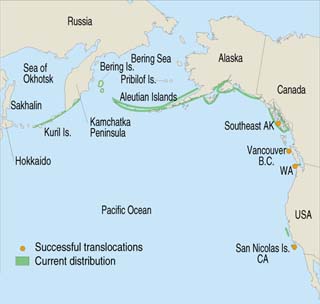This is a brief review of the history of the relationship between sea otters and humans. Leading sea otter experts from the National Biological Service, James L. Bodkin, Ronald J. Jameson, and James A. Estes offer their thoughts on potential sources of conflict between sea otters and humans.
|
Start of fur trade The web site for the United States Library of Congress documents the history of the sea otter fur trade with the Russian colonization of Alaska during the late 1700s. Native Alaskan tribes had been hunting sea otters for food and their pelt for many generations. However, the start of the international sea otter fur trade that eventually led to its near extinction is accredited to a Danish sea captain, Vitus Bering, of the Russian Navy. Vitus Bering returned to Russia from his second expedition to Kamchatka in 1741-42 with sea otter pelts for barter. The pelts were soft and provided incredible warmth. This quickly became the dominant economy of Alaska for more than 150 years. Initially, Russian frontier merchants indentured native Aleut hunters to procure furs for them. In time, larger Russian joint-stock companies, like the Russian-American Company, replaced the individual trappers and traders. China eventually grew to be the key market with Russian, British, and American trading ships bringing their trade directly to Chinese ports. The upper classes sought the luxurious pelts for their clothing. By the end of the fur trade in 1911, almost 1 million sea otters had been slaughted, and the population worldwide had dwindled from 300,000 to about 1,000. Go to the Library of Congress web site to learn more about the Russian and American history in Alaska. (alaska.fws.gov/mmm/otter/history.html; memory.loc.gov/intldl/mtfhtml/mfak/mfaktour.html) |
|
What is so special about sea otter fur? Unlike other marine mammals, sea otters to do not have a thick layer of fat to keep them warm. Instead, they rely on very dense fur with an insulating underfur and a layer of long guard hairs over the top that trap a layer of air, adding further to the insulation. The fur can be as dense as 1,000,000 hairs per square inch! There are 100,000 hairs on the entire human head. It was the demand for this warm and luxurious fur, among the finest in the world, that led to their near extinction. |
|
When and how did the fur trade end? In 1911, the U.S., Russia, Japan, and Great Britain signed the International Fur Seal Treaty, which outlawed the sale of sea otter fur. The U.S. Marine Mammal Protection Act in 1972 and Endangered Species Act in 1977 also helped to further protect the sea otters. In order to not exclude indigenous culture and customs, Native Alaskans are allowed to hunt and use sea otter parts as long as these practices are consistent with their traditional customs. They are not allowed to sell or give sea otter pelts to any person that is not a Native Alaskan by blood. There are many other extensive restrictions and regulations regarding these allowances. |
|
|
This web site was created by Lynn Tran at the North Carolina State University, Department of Mathematics, Science, and Technology Education on 7/12/03. Faculty advisor Dr. David Eggleston, NCSU, Department of Marine, Earth, & Atmospheric Sciences. Last updated December 29, 2003 .
